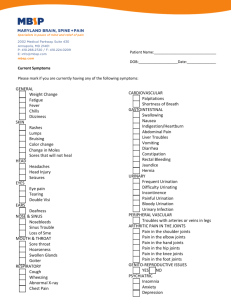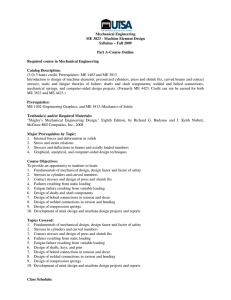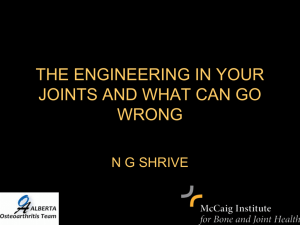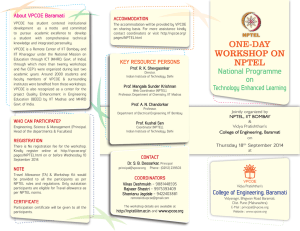File
advertisement
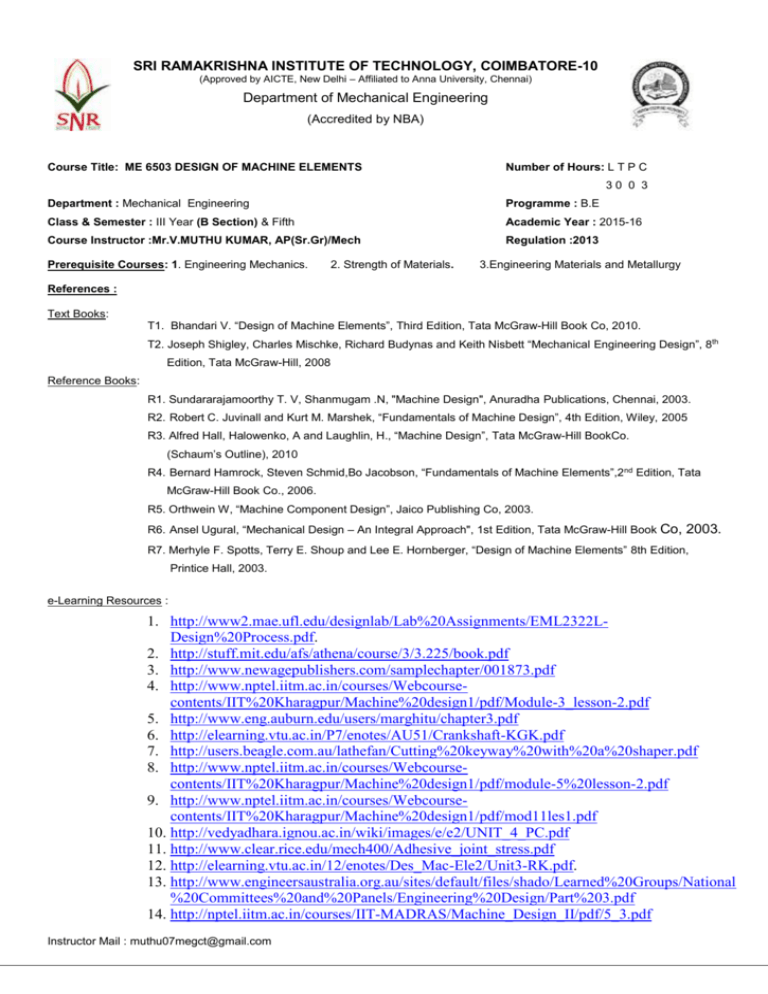
SRI RAMAKRISHNA INSTITUTE OF TECHNOLOGY, COIMBATORE-10 (Approved by AICTE, New Delhi – Affiliated to Anna University, Chennai) Department of Mechanical Engineering (Accredited by NBA) Course Title: ME 6503 DESIGN OF MACHINE ELEMENTS Number of Hours: L T P C Department : Mechanical Engineering Programme : B.E Class & Semester : III Year (B Section) & Fifth Academic Year : 2015-16 Course Instructor :Mr.V.MUTHU KUMAR, AP(Sr.Gr)/Mech Regulation :2013 30 0 3 Prerequisite Courses: 1. Engineering Mechanics. 2. Strength of Materials. 3.Engineering Materials and Metallurgy References : Text Books: T1. Bhandari V. “Design of Machine Elements”, Third Edition, Tata McGraw-Hill Book Co, 2010. T2. Joseph Shigley, Charles Mischke, Richard Budynas and Keith Nisbett “Mechanical Engineering Design”, 8th Edition, Tata McGraw-Hill, 2008 Reference Books: R1. Sundararajamoorthy T. V, Shanmugam .N, "Machine Design", Anuradha Publications, Chennai, 2003. R2. Robert C. Juvinall and Kurt M. Marshek, “Fundamentals of Machine Design”, 4th Edition, Wiley, 2005 R3. Alfred Hall, Halowenko, A and Laughlin, H., “Machine Design”, Tata McGraw-Hill BookCo. (Schaum’s Outline), 2010 R4. Bernard Hamrock, Steven Schmid,Bo Jacobson, “Fundamentals of Machine Elements”,2 nd Edition, Tata McGraw-Hill Book Co., 2006. R5. Orthwein W, “Machine Component Design”, Jaico Publishing Co, 2003. R6. Ansel Ugural, “Mechanical Design – An Integral Approach", 1st Edition, Tata McGraw-Hill Book Co, 2003. R7. Merhyle F. Spotts, Terry E. Shoup and Lee E. Hornberger, “Design of Machine Elements” 8th Edition, Printice Hall, 2003. e-Learning Resources : 1. http://www2.mae.ufl.edu/designlab/Lab%20Assignments/EML2322LDesign%20Process.pdf. 2. http://stuff.mit.edu/afs/athena/course/3/3.225/book.pdf 3. http://www.newagepublishers.com/samplechapter/001873.pdf 4. http://www.nptel.iitm.ac.in/courses/Webcoursecontents/IIT%20Kharagpur/Machine%20design1/pdf/Module-3_lesson-2.pdf 5. http://www.eng.auburn.edu/users/marghitu/chapter3.pdf 6. http://elearning.vtu.ac.in/P7/enotes/AU51/Crankshaft-KGK.pdf 7. http://users.beagle.com.au/lathefan/Cutting%20keyway%20with%20a%20shaper.pdf 8. http://www.nptel.iitm.ac.in/courses/Webcoursecontents/IIT%20Kharagpur/Machine%20design1/pdf/module-5%20lesson-2.pdf 9. http://www.nptel.iitm.ac.in/courses/Webcoursecontents/IIT%20Kharagpur/Machine%20design1/pdf/mod11les1.pdf 10. http://vedyadhara.ignou.ac.in/wiki/images/e/e2/UNIT_4_PC.pdf 11. http://www.clear.rice.edu/mech400/Adhesive_joint_stress.pdf 12. http://elearning.vtu.ac.in/12/enotes/Des_Mac-Ele2/Unit3-RK.pdf. 13. http://www.engineersaustralia.org.au/sites/default/files/shado/Learned%20Groups/National %20Committees%20and%20Panels/Engineering%20Design/Part%203.pdf 14. http://nptel.iitm.ac.in/courses/IIT-MADRAS/Machine_Design_II/pdf/5_3.pdf Instructor Mail : muthu07megct@gmail.com Course Objectives : 1 .To familiarize the various steps involved in the Design Process 2. To understand the principles involved in evaluating the shape and dimensions of a component to satisfy functional and strength requirements. 3. To learn to use standard practices and standard data 4 To learn to use catalogues and standard machine components Course Plan 1 2 3 Unit Unit I - STEADY STRESSES AND VARIABLE STRESSES IN MACHINE MEMBERS Sl. No. Topics to be Discussed Unit Objectives Introduction to the design process – factors influencing machine design, selection of materials based on mechanical properties-Preferred numbers, fits and tolerances Direct, Bending and torsional stress equations – Impact and shock loading – calculation of principle stresses for various load combinations, eccentric loading Design of curved beams – crane hook and ‘C’ frame - Factor of safety - theories of failure – stress concentration – design for variable loading. To understand the design process and selection of materials for machine members To able to understand the variable stresses induced in the machine members To able to understand the factor of safety of various machine members Reference Page No T1 2-12, 65-69 No. of Periods Required T1 76-85, 102-106, 180-182 4 T1 130-140, 77-79, 106-117, 141-165 4 4 5 6 Unit II-SHAFTS AND COUPLINGS Total Hours: Design of solid and hollow shafts based on strength, rigidity and critical speed Design of keys, key ways and splines To able to understand the design of shaft based on strength and stiffness. To able to Know the stresses induced in the Keys. Design of rigid and flexible Couplings To able to understand the need of coupling and difference between coupling and clutch 2 10 330-344, 3 T1 346-354 1 T1 356-371 4 T1 7 8 9 UNIT III - TEMPORARY AND PERMANENT JOINTS Total Hours : 08 Threaded fasteners - Design of bolted joints including eccentric loading Knuckle joints, Cotter joints To able to know the difference between temporary and permanent joints. To able to know the application of knuckle and cotter joints. Design of welded joints, riveted joints for structures- Theory of bonded joints. To able to know the strength of welded joints Design of springs, To able to know the types of springs and its applications. T1 219-254 3 T1 94-102, 85-94 2 T1 272-305 4 10 11 12 UNIT IV ENERGY STORING ELEMENTS AND ENGINE COMPONENTS Total Hours: 09 various types of optimization of helical springsrubber springs Design of flywheels considering stresses in rims and arms, for engines and punching machines. To able to know the optimum parameter of spring. To able to understand the stresses induced in rims and arms. T1 T1 T1 393-403 3 403-447 3 750-767, 1 Design of Connecting Rods and crank shafts. 13 To able to know the forces acting on the connecting rod. T1 867-880 880-903 2 Total Hours: 09 UNIT V BEARINGS 14 15 Design of Sliding contact and rolling contact bearings Design of hydrodynamic journal bearings, Sommerfield Number, Raimondi & Boyd graphs, Selection of Rolling Contact bearings. To able to know the selection of lubricating oil of sliding contact and rolling contact bearings. To able to know the static and dynamic load carrying capacity of bearings T1 T1 606-647 4 564-596 5 Total Hours: 09 Bridging the Curriculum gap: 16 Topic 1 Creep 17 Topic 2 Modes of Failure To able to know the deformation of a component under constant load To able to know the functional performance of a component T1 50-52 2 T1 76-77 1 Total Hours:3 Additional Contents over and above the curriculum: 18 Module 1 19 Module 2 Design Considerations of Castings Design considerations of Forgings To able to know the stresses induced in a castings To able to know the principle of forged components T1 57-59 1 T1 59-61 2 Total Hours :3 Total duration required : 45 periods +3 periods for bridging the curriculum gap+ 3 periods for over and above curriculum+ 6 periods for Tests = 57 Periods Programme Educational Objectives PEOs This Course is conducted to achieve the following Programme Educational Objectives (PEOs): • PEO 1. Be able to apply the principles of Mechanical engineering to solve real time problems and succeed in their career. • PEO 2.Be able to contribute and communicate effectively in multidisciplinary projects and perform services related to mechanical engineering to meet the customer requirements in both quality and quantity. • • PEO 3.Be able to update the modern trends in engineering and technology through continuous learning and be the leaders in their profession. Program Outcomes (POs) • PO1: An ability to solve basic Engineering problems by applying mathematics, science, and engineering fundamentals. • PO2: An ability to conduct Investigations using design of experiments, analysis and interpretation of data to arrive at valid conclusions. • PO3: An ability to design a mechanical engineering component and processes within economic, environmental, ethical and manufacturability constraints. • PO4: Ability to identify, formulate, analyze and solve Mechanical Engineering Problems. • PO5: An ability to communicate effectively through written reports or oral presentations. • PO6: An ability to understand the impact of engineering solutions in a global, economic, environmental, professional and societal context. • PO7: An ability to recognize the need and to engage in independent and life-long learning. • PO8: An ability to have knowledge of contemporary issues • PO9: An ability to use the appropriate techniques and modern engineering tools necessary for engineering practice. • PO10: An ability to apply the principles of management to manage projects Multidisciplinary environment. Course Outcome: At the End of the Course , a student will be able to Apply CO1: Analyze the component and investigate the stresses induced in it Analyze CO2: Design and analyze the shaft based on strength and Rigidity CO3: Design Machine elements such as couplings, Design of welded joint, Threaded Fastners,springs, flywheel Create and bearing etc using allowable load under the given operating conditions Mapping: CO1 CO2 CO3 1 2 PO1 2 1 1 PO2 1 2 2 PO3 2 2 2 PO4 2 1 2 PO5 PO6 1 PO7 PO8 1 PO9 1 2 1 PO10 1 1 Moderately Correlated Strongly Correlated Assignments / Tutorials / Case Study / Innovative Work : Tutorials: T1.Problems in Theories of failure T2.Problems in design of Couplings T3.Problems in design of welded joints T4. Problems in design of springs T5. Problems in design of bearings 1. Internal Assessment (20) Internal Assessment Test 1 will be conducted for 50 Marks. (5*2=10 & 2*20=40) Internal Assessment Test 2 will be conducted for 50 Marks. (5*2=10 & 2*20=40) Internal Assessment Test 3 will be conducted for 50 Marks. (5*2=10 & 2*20=40) Tests as per the schedule given by the university - Average performance is considered for assessment out of 20. 2. External Assessment (80) University will conduct end semester examination for 100 marks (10*2=20 & 5*16=80) Performance will be considered for assessment out of 80. COURSE INSTRUCTOR HoD-MECH PRINCIPAL

